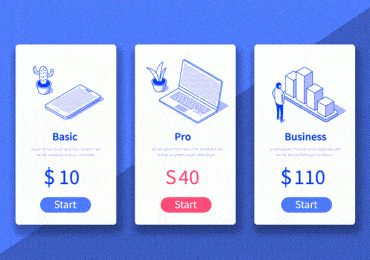Whenever you’re ready to launch your product to the market, the final point to consider is how much money you will charge for it. This question is not an easy one, especially for SaaS businesses delivering intangible services. Here is an exhaustive guide to setting a pricing strategy and developing a relevant pricing model fitting your product.
Choose a Strategy First
The initial step in pricing-related decision-making is the choice of a pricing strategy. Experts distinguish the following types to choose from.
#1 Competitor-based Pricing
If you don’t know what price to set, the easiest method is to look at that of competitors. Make sure to analyze both top performers and small businesses to determine the price range in your niche. Based on that data, you can decide on the fair starting price and set guidelines for price scaling as you develop and grow.
#2 Penetration Pricing
The plus of a penetration pricing strategy is that it can help you engage many new users quickly. It suggests setting the lowest possible price for your service as a trick for user accumulation. After that, you can change the pricing strategy and charge more reasonable prices from your subscribers.
#3 Cost-based Pricing
When you opt for cost-based pricing, all you need to do is add the desired profit margin to the sum of your expenses. It’s the simplest strategy, but it still doesn’t work well on a stable basis as it’s not sensitive to the end consumer’s readiness to pay a specific price.
#4 Value-based pricing
Charging money with reference to the service’s value is the most sensitive and realistic of all SaaS pricing approaches. This strategy places the end consumer in the center of decision-making. Thus, adding tiers with extra features gives clients a choice and serves various customers depending on their needs.
Tips for Choosing Your Pricing Approach
Now that you’ve decided about your strategy, it’s time to proceed to the pricing models. You can choose any of the following:
- A flat-rate model is a one-size-fits-all approach with one price for everyone.
- Price tiers include various price levels, from basic to premium, each coming with a greater set of features.
- The usage-based pricing model follows the “pay as you go” principle and features dynamic pricing depending on the intensity of service use.
- User-based pricing involves charging higher prices for larger user teams.
- Per-feature pricing – the price changes incrementally with every added feature. The model is highly customizable, allowing clients not to pay for unnecessary features.
- Freemium pricing – users can use services for free with the basic set of features or by watching commercial ads. Premium versions come at a price and offer expanded feature sets or ad-free environments.
What’s Next?
Now that you know how to pick the proper pricing method for your business, it’s time to communicate it to your customers. Keep in mind that an effective SaaS pricing page design also matters. This page should be clear regarding pricing tiers and conditions so that users know the options and packages coming with each.
Besides organizing the payment opportunities for users, you need to check whether your choice was right. Use the following metrics to see how it works:
- Assess the lifetime value (LTV) and custom acquisition cost (CAC) ratios for your product to ensure that your business model stays profitable.
- Take a closer look at the MRR churn ratio. It Is the revenue loss of your business resulting from subscription cancelations or downgrades.
- Consider the expansion MRR, which shows the additional revenue generated from existing customers’ upsells and extra service purchases.
- Take notice of your monthly upgrade MRR, which indicates the number of users choosing more expensive subscription tiers.
With this data at hand, you’ll be in perfect control of your pricing strategy, making tweaks and adjustments at the times when it loses relevance. Don’t forget to scale your prices together with your business; the price of your services should reflect the fair product value at each point in time.


